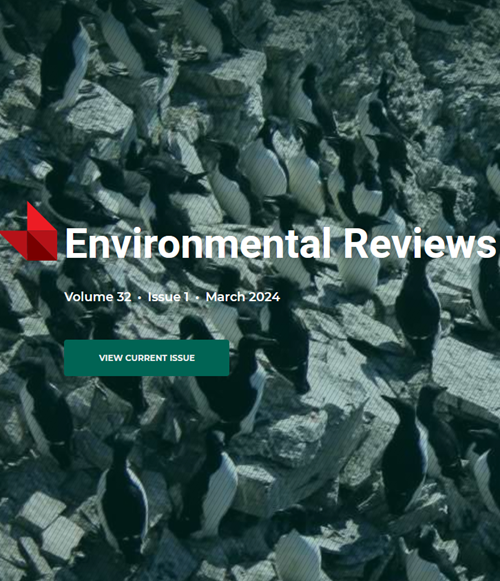Future-proofing the Emergency Recovery Plan for freshwater biodiversity
IF 5.1
3区 环境科学与生态学
Q2 ENVIRONMENTAL SCIENCES
引用次数: 1
Abstract
Freshwater biodiversity loss is accelerating globally, but humanity can change this trajectory through actions that enable recovery. To be successful, these actions require coordination and planning at a global scale. The Emergency Recovery Plan for global freshwater biodiversity aims to reduce the risk for freshwater biodiversity loss through six priority actions: 1) accelerate implementation of environmental flows; 2) improve water quality to sustain aquatic life; 3) protect and restore critical habitats; 4) manage exploitation of freshwater species and riverine aggregates; 5) prevent and control nonnative species invasions in freshwater habitats; and 6) safeguard and restore freshwater connectivity. These actions can be implemented using future-proofing approaches that anticipate future risks (e.g., emerging pollutants, new invaders, synergistic effects) and minimize likely stressors to make conservation of freshwater biodiversity more resilient to climate change and other global environmental challenges. While uncertainty with respect to past observations is not a new concern for freshwater biodiversity, future-proofing has the distinction of accounting for the uncertainty of future conditions that have no historical baseline. The level of uncertainty with respect to future conditions is unprecedented. Future-proofing of the Emergency Recovery Plan for freshwater biodiversity will require anticipating future changes and developing and implementing actions to address those future changes. Here, we showcase future-proofing approaches likely to be successful using local case studies and examples. Ensuring that response options within the Emergency Recovery Plan are future-proofed will provide decision-makers with science-informed choices, even in the face of uncertain and potentially new future conditions. We are at an inflection point for global freshwater biodiversity loss; learning from defeats and successes can support improved actions towards a sustainable future.面向未来的淡水生物多样性紧急恢复计划
全球淡水生物多样性的丧失正在加速,但人类可以通过恢复行动来改变这一轨迹。为了取得成功,这些行动需要在全球范围内进行协调和规划。全球淡水生物多样性紧急恢复计划旨在通过六项优先行动降低淡水生物多样度丧失的风险:1)加快实施环境流动;2) 改善水质以维持水生生物;3) 保护和恢复重要栖息地;4) 管理淡水物种和河流骨料的开采;5) 防止和控制外来物种入侵淡水栖息地;以及6)保护和恢复淡水连通性。这些行动可以使用经得起未来考验的方法来实施,这些方法可以预测未来的风险(例如,新出现的污染物、新的入侵者、协同效应),并最大限度地减少可能的压力,使淡水生物多样性的保护更能应对气候变化和其他全球环境挑战。虽然过去观测的不确定性并不是淡水生物多样性的新问题,但未来验证的区别在于考虑了没有历史基线的未来条件的不确定性。未来情况的不确定性程度是前所未有的。淡水生物多样性紧急恢复计划的未来验证将需要预测未来的变化,并制定和实施行动来应对这些未来的变化。在这里,我们通过当地的案例研究和例子展示了可能成功的经得起未来考验的方法。确保应急恢复计划中的应对方案经得起未来考验,将为决策者提供科学的选择,即使面对不确定和潜在的新的未来条件。我们正处于全球淡水生物多样性丧失的转折点;从失败和成功中吸取教训可以支持为实现可持续的未来而改进行动。
本文章由计算机程序翻译,如有差异,请以英文原文为准。
求助全文
约1分钟内获得全文
求助全文
来源期刊

Environmental Reviews
环境科学-环境科学
自引率
3.50%
发文量
45
期刊介绍:
Published since 1993, Environmental Reviews is a quarterly journal that presents authoritative literature reviews on a wide range of environmental science and associated environmental studies topics, with emphasis on the effects on and response of both natural and manmade ecosystems to anthropogenic stress. The authorship and scope are international, with critical literature reviews submitted and invited on such topics as sustainability, water supply management, climate change, harvesting impacts, acid rain, pesticide use, lake acidification, air and marine pollution, oil and gas development, biological control, food chain biomagnification, rehabilitation of polluted aquatic systems, erosion, forestry, bio-indicators of environmental stress, conservation of biodiversity, and many other environmental issues.
 求助内容:
求助内容: 应助结果提醒方式:
应助结果提醒方式:


